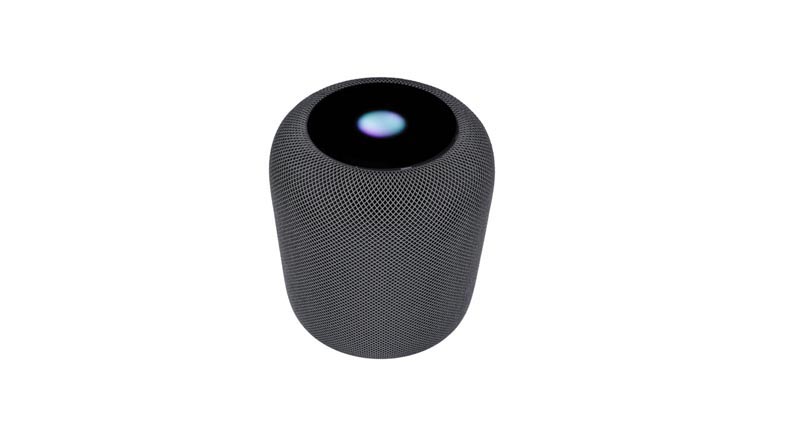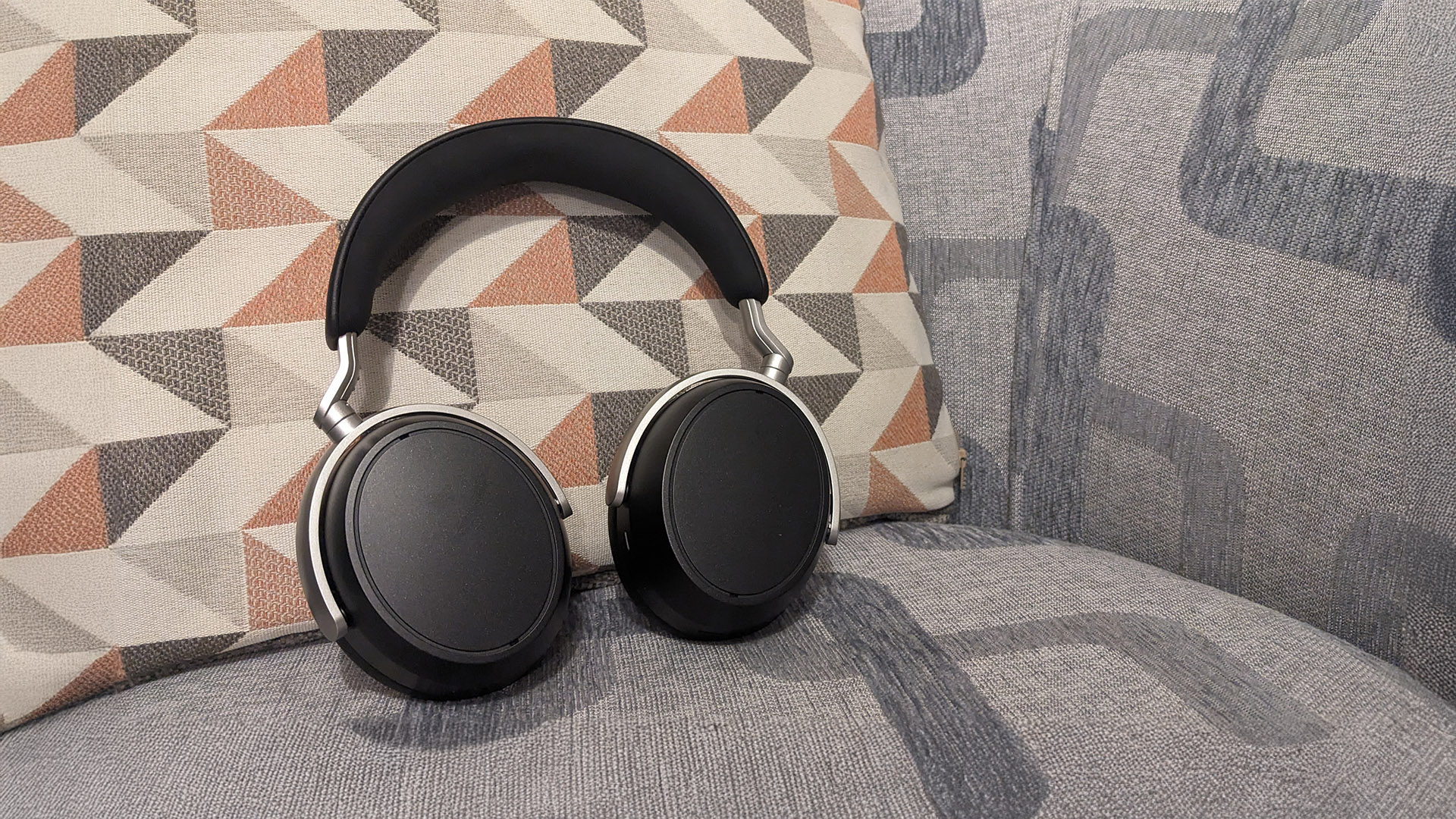What Hi-Fi? Verdict
The best-sounding, most music-oriented smart speaker currently available
Pros
- +
Compact, solid and stylish
- +
Siri and Apple Music works well
- +
Weighty, authoritative sound
Cons
- -
Over-reliance on voice control
- -
Mid-range a little muddled
- -
Very Apple-centric
Why you can trust What Hi-Fi?
That Apple does things in its own sweet time is no new discovery. But even by its own standards, the company arrived late to the wireless speaker party.
But being late is perfectly acceptable if you’re the life and soul when you arrive – and that’s pretty much the story with the HomePod.
Despite some flaws and limitations, the HomePod is the best-sounding smart speaker available – and by quite a margin.
When combined with Siri’s reinvention as your personal DJ/musical guru, it makes for an endlessly entertaining all-in-one system. Assuming you’re already deep in the Apple ecosystem.
- The best Apple deals: cheapest prices on AirPods, Apple TV, HomePod and more
- Apple HomePod 2, HomePod Mini: release date, leaks and all of the news
- Apple HomePod mini vs HomePod: specs, price and features compared
Build
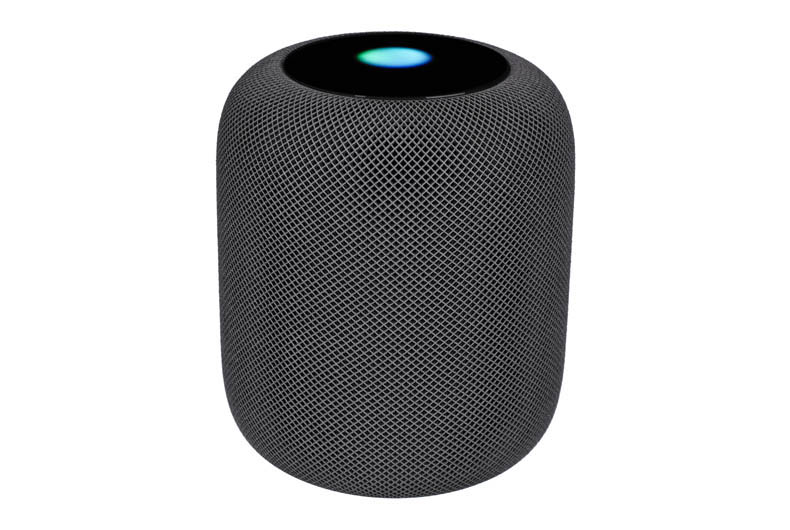
It comes as no surprise that the HomePod is beautifully made and looks classy. It’s a bit smaller and much heavier than you might imagine – dense in the manner of dark matter.
It’s also a subtly styled device, particularly in the Space Grey finish of our review sample. This is a speaker that, between its cylindrical shape and seamless mesh fabric cover, is designed to blend into, rather than dominate, its surroundings.
Not that it’s without neat touches. That glossy top panel, uniformly black when the speaker is resting, is where Siri appears as a shifting ball of colour. The way it floats within the blackness of the panel is undeniably cool.
The latest hi-fi, home cinema and tech news, reviews, buying advice and deals, direct to your inbox.
When playing music, '+' and '-' symbols appear, giving you touch-points to raise or lower the volume. Tapping the centre of the surface will play/pause, skip track or go back to the previous track, while keeping your finger pressed summons Siri.
MORE: Apple HomePod tips, tricks and features

But the really impressive stuff is hidden beneath that acoustically transparent mesh. Having started with an entirely clean slate and apparently worked on concepts for years (HomePod development began in 2012), Apple eventually settled on having the tweeters at the bottom and the woofer at the top – the exact opposite of the arrangement found in most traditional speakers.
The tweeters fire outwards and are angled slightly upwards, with the intention of not bouncing sound off the surface upon which the HomePod is placed. By avoiding these reflections, Apple can exert greater control over the treble’s behaviour.
There are seven tweeters in total, evenly spaced around the base of the unit. The woofer is close to the top and fires upwards, reflecting mid and bass frequencies off the bottom of that glossy panel so they are distributed equally around the device. It’s an energetic driver too, capable of moving a full 20mm from peak-to-peak, which is extraordinary excursion for a compact driver in a dinky wireless speaker.
Embedded in the underside of the top panel, shielded from the bassy battering it receives from the woofer below, is Apple’s A8 chip. This is the same chip that first appeared inside the iPhone 6 and 6 Plus back in 2014. That might make it sound rather old, but for a wireless speaker it’s quite the powerhouse.
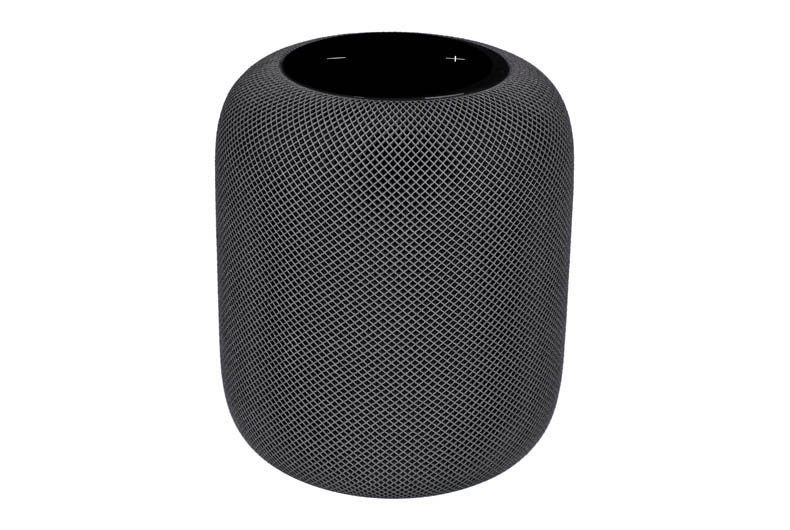
So, what’s all of that processing power used for? There’s Siri, of course – but, perhaps more interestingly, it's employed by the HomePod to analyses the speaker’s surroundings and the music being played to ensure you always hear the HomePod at its best.
The surroundings are only analysed when you use the HomePod for the first time or move it to a new position (there are accelerometers to let it know) and, unlike the implementation of most Sonos speakers, involves no manual measuring on the part of the user. Instead, the HomePod uses the first song you play to listen to itself and adjust the sound accordingly.
If it’s in free space, sound will be dispersed equally around the speaker, but if it’s close to a back wall the HomePod will actively split out some of the more ambient elements of your music and bounce them off the rear surface while projecting the vocals and more direct sounds straight into the room. It’s clever stuff.
Wherever you place the speaker, it is constantly analysing the music you play and dynamically tuning the sound, from bass to treble, to deliver the track as intended. Or, at least, as the HomePod thinks it’s intended.
Sound

But it seems the HomePod has a good grasp of the intentions of a track. At no point in our test do we play a single piece of music that sounds anything other than absolutely correct.
That’s not to say we’re talking about a perfect delivery, but the HomePod is great at honing in on and delivering the essence of everything you play through it, from Bach to Band of Horses, Bonobo to Bob Marley, The Notorious B.I.G. to Bullet for My Valentine.
It’s all well and good having a bass driver that can shift some serious air, but keeping it controlled at the same time is a tricky business. The HomePod manages it expertly.
Play Join the Dots by Roots Manuva and Charli 2na and you can revel in bass that’s superbly deep for a little speaker, but it's also tuneful, energetic and punchy, putting to rest any fears the HomePod might be a little too Beats-like in its delivery.
Instead, this is an expressive bottom end – which is essential to getting the most out of the deep brass and deep vocal on the track.
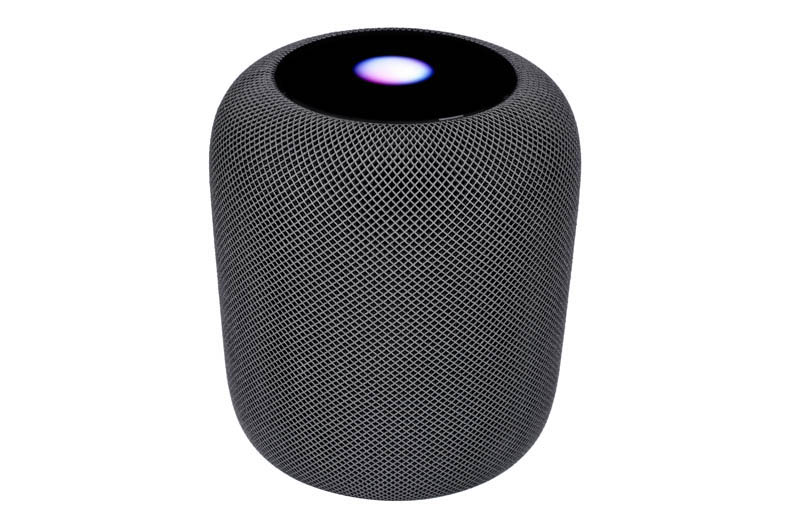
At the other end of the frequency range, the expertly judged treble delivers the snap and detail of the high hat without ever sounding bright or aggressive.
Even a track featuring Charli 2na has lots of mid-range action, and the HomePod does a good job of projecting the vocals and horns.
At the most congested points, the HomePod becomes just a little muddled and some rivals (such as the Ultimate Ears Megablast) offer a little more clarity in their organisation. But for scale, authority, drive and excitement, the Apple speaker is just superb.
The HomePod can turn its hand to anything, and is just as happy playing The Road by Nick Cave and Warren Ellis (“happy” is the wrong word for this collection, but you get the drift). The centralised, simple, solo piano notes at the start of the title track lack the nuance of true, traditional hi-fi - but there’s more texture here than you would expect from a small, all-in-one speaker.
It does a superb job of upping the ante as each mournful component is added on the way to the tear-jerking crescendo.
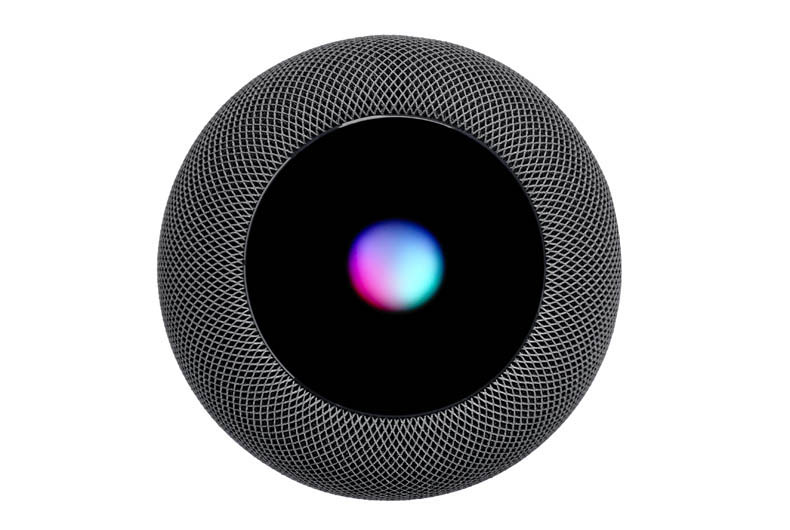
What's more, you don’t need to pump up the volume in order to get the HomePod singing.
Even at low volumes the core excitement is retained, with more bass weight and punch than rivals can muster when similarly quiet. It’s also capable of going very loud, though, and remains composed, clear and unflustered even at maximum volume.
Apple’s promise of 360-degree sound is, unlike many similar promises made by other brands in the past, also pretty darn accurate. With the HomePod standing in free space, the sound you hear is very consistent regardless of where you are in relation to it.
Yes, there are slight variances as you walk slowly in a circle around it – a small drop in treble, for example, presumably as you step between the beams of two tweeters – but every part of (and person in) a room will get more or less the same excellent audio quality.
Even when the HomePod is placed close to a back wall, the sound around the room is pretty consistent right until you’re essentially standing at a right-angle to it. This is our preferred positioning of the speaker, as the reflection of ambient effects on the surface behind creates a slightly bigger, more spacious and more three-dimensional presentation.
There’s not enough in it for you to be upset should you not have a wall to place the HomePod next to, though.
Should you have the appetite and capital for such a setup, you can now combine two HomePods in a stereo pair, and the performance if you do so is even better than expected.
You of course get a far wider soundstage, with traditional left and right separation, but there’s also excellent panning across the front and impressive central focus for the musical elements that require it – the vocals, for example.
But what’s most impressive is how two paired HomePods continue to use their processing smarts to bounce the more ambient sounds of a track off the wall behind, and the extra spaciousness and three-dimensionality that this lends to the music.
This is a big, open, atmospheric performance – much more so than rival pairs of wireless speakers can manage – and two HomePods working in concert also sound predictably weighty and solid.
The only slight flaw is that the sound isn’t projected into the room quite as effectively as that of some rivals or, in fact, a pair of traditional hi-fi speakers. In the average room it won’t be an issue, but if you sit a long way from the two HomePods you will notice that the lovely spaciousness has come at the cost of a little directness.
Features
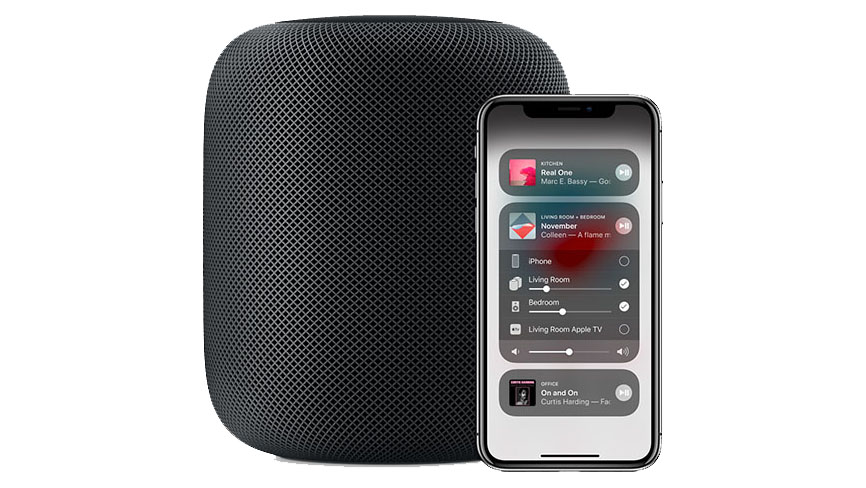
If you’re an Android fan and have made it this far into the review, well done. But the bad news is the HomePod is not for you. Not only does it not have a standard Bluetooth connection, you can’t even set one up without an iOS device.
On the surface of it that might seem unfair, but we don’t think that anyone who doesn’t already own Apple devices will choose the HomePod as their first. That just wouldn’t make sense.
Assuming you are an Apple user (running at least iOS 11.2.5), setting up the HomePod is an absolute delight. Simply hold your iPhone or iPad close to the speaker’s top panel and it will appear on your screen. Select the room that you’re using it in, enable personal requests and tap once more to transfer your settings, and the HomePod is good to go.
Interestingly, the HomePod doesn’t have a dedicated app on your iOS device. A small number of settings are available via the Home app (which is where you’ll also find any Apple HomeKit smart home devices) and you can skip back and forth through tracks and adjust volume in the Apple Music app - but this is largely a hands-off, voice-controlled user experience, with all the consequent pros and cons.
MORE: Apple Music review

The big pro is that Siri is surprisingly good here. Apple clearly tailored it for music in the run up to launch, and in concert with Apple Music’s superior curation engine it makes for rewarding interactions in a musical context.
Say “hey, Siri, play something I’ll like”, and the voice assistant will use its knowledge of your music tastes to select something that you may enjoy, rather than something you already listen to. But if that’s not what you’re in the mood for, say “play something different” and Siri will choose something from a different genre or era, but still within the realms of what you'll probably like.
The result is that you’re regularly surprised and delighted by Siri’s choices, as you might be by the recommendations of a friend who knows the kind of stuff you're into. This really elevates the HomePod experience over that offered by Alexa and Google.
Siri understands context better than rivals, too. So if, for example, you say “play Alison” and get the Elvis Costello track when you wanted Slowdive, following up with “play the other one” will get you to the track you were after.
There’s also nuance to Siri’s knowledge, opening up slightly more complex requests. It understands “post-punk music for a party”, for instance, or “romantic music from the 70s”.
Combined with the many different ways you can issue an instruction or ask a question, these things make for natural and useful interactions with Siri.
It’s also worth noting that a) HomePod does a genuinely impressive job of hearing your instructions over the loudest music, even when you can barely hear your own voice, and b) it's now even better for busy households whereby more than one family member is using the smart speaker because iOS 13 introduced the ability for HomePod to distinguish between different voices and offer a more personalised experience to each user.
MORE: Best wireless speakers 2020

The almost complete reliance on Siri does have its drawbacks, though. For example, adding a track to your current queue is something that can only be done using your voice, which means constantly interrupting what you’re already playing.
And there are, of course, occasional stutters and misunderstandings which, even after a long sequence of positive interactions, can shatter the illusion.
Overall, though, we’ve been pleasantly surprised by the overall efficacy of Siri, particularly having been largely unimpressed by it in iPhones and iPads over the last few years. It seems Apple's tailoring of its voice assistant to music has made it a more solid and useful performer in the context of a wireless speaker.

Siri will do more than control your music: you can control your lights or heating, read out and reply to messages, find cinema tickets, read news headlines and all sorts of other tricks. But the focus is music, and we’re all for that.
But the HomePod is still more limited than many rivals when it comes to playing the content you want. Apple Music is still the only streaming service that Siri can control (as well as podcasts and anything you’ve stored in your iCloud Music Library), and there's no proper integration of the likes of Tidal, Spotify or Qobuz. Standard radio stations are, thankfully, now natively supported, but BBC Sounds is not on board and so playing BBC stations is somewhat fiddly.
We’d love to say that AirPlay 2 gives you the ability to use your iOS device as a controller to direct the HomePod to stream content straight from the internet – which is how Sonos has always worked – but, alas, that’s not the case. Instead, with AirPlay 2 your iOS device acts as a source, which slightly limits sound quality and reduces battery life.
MORE: Apple AirPlay 2 - everything you need to know

The update to AirPlay 2 has, though, also brought with it support for multi-room. This works exactly as expected – add each HomePod (or supported speakers from other brands such as Sonos, Naim and B&O) to a specific room and, via Siri commands, you can play the same music everywhere or different tracks in different rooms. We’ve had no issues with synchronisation across speakers during testing.
We noted in the original version of this review that the lack of sleep timers, and the inability to set alarms that wake you up with anything but Apple’s own chimes, make the HomePod a less-than perfect bedroom speaker in its own right. That's another issue that has now been addressed. Finally, the HomePod has a sleep timer, allowing owners to set their HomePod to stop playing music after a set amount of time.
Owners can now seamlessly transfer music playback from an iPhone to the smart speaker, too. HomePod users can 'hand-off' the music/call they're listening to/taking on their iPhone simply by placing it close to a HomePod, and vice versa.
Verdict
The HomePod still isn't perfect, but the addition of multi-room support and, to a slightly lesser extent, stereo pairing has closed two of the biggest gaps in its feature set, and the addition of native radio stations and sleep timers is good news, too.
You still need to be a dedicated Apple user to even consider the HomePod, and Apple Music needs to be your default streaming service for you to get anything like the best out of it.
If that sounds like you, the HomePod is the party-rocking, musical horizon-broadening smart speaker you’ve been waiting for.
- Best wireless speakers 2020
- Best Apple deals: HomePod, AirPods and AirPods Pros
- How the HomePod was made: a tale of obsession from inside Apple's audio labs
- See all our Apple reviews
What Hi-Fi?, founded in 1976, is the world's leading independent guide to buying and owning hi-fi and home entertainment products. Our comprehensive tests help you buy the very best for your money, with our advice sections giving you step-by-step information on how to get even more from your music and movies. Everything is tested by our dedicated team of in-house reviewers in our custom-built test rooms in London, Reading and Bath. Our coveted five-star rating and Awards are recognised all over the world as the ultimate seal of approval, so you can buy with absolute confidence.
